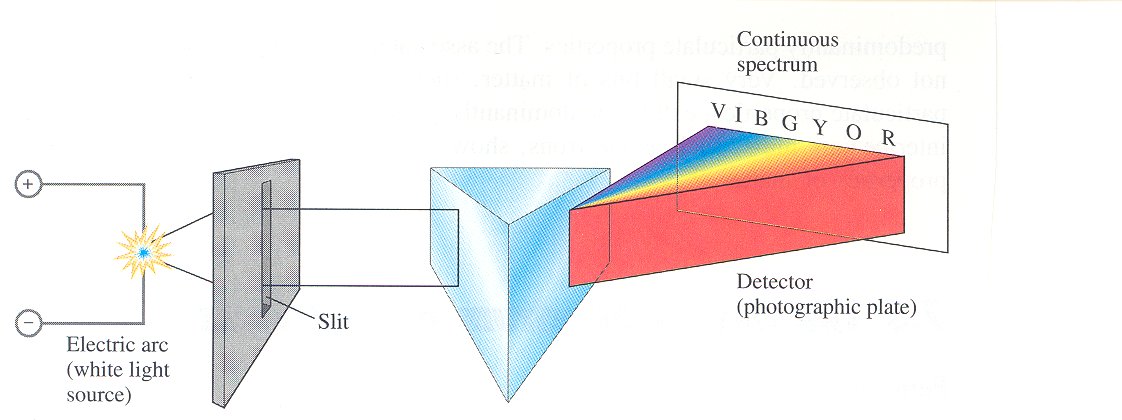

Note that the wave moves to the right but the string moves up, i.e. perpendicular to the direction of the wave. The top curve of the wave is called the crest and the bottom curve of the wave is called the trough. The Greek letter "lambda" ( ) is used for
the distance between two successive crests (the wavelength). The greek letter "nu" (
) is used for
the distance between two successive crests (the wavelength). The greek letter "nu" ( ) is used to indicate the number of crests or troughs that pass a given point in a unit of time (the frequency with
units of s-1).
) is used to indicate the number of crests or troughs that pass a given point in a unit of time (the frequency with
units of s-1).
The distance that the wave traveled in one second is called the velocity of the wave and is given by
![]()
 Go here for an excellent site to look at the relationship between wavelength, frequency, and velocity.
Go here for an excellent site to look at the relationship between wavelength, frequency, and velocity.
An electromagnetic wave is caused by oscillating charged particles and consists of three-dimensional electric and magnetic waves perpendicular to each other and require no medium for propagation.
The SI unit for frequency is hertz (Hz). The wavelength unit is the meter, but these wavelengths are so small that we need to use nanometer, or angstrom (10-10m), or micron (10-6m), or millimicron (10-9m -- note that this is a nanometer).
The velocity of electromagnetic waves in vacuum is
c = ![]() *
* = 2.997925 x 108
m/s ~ 3.00 x 108m/s
= 2.997925 x 108
m/s ~ 3.00 x 108m/s
The speed of light is a function of the medium. Thus an electromagnetic ray is bent or refracted as it passes from one medium to another. The amount of the refraction is also a function of the wavelength so a light ray consisting of different wavelengths is dispersed into a spectrum of colors as it passes through a medium. White light is really polychromatic (many colored) and a light ray of a single frequency is called monochromatic.
We have probably all played with prisms to see how light is refracted into different colors. I remember playing with such as a child and being fascinated watching the different colors from the prism. A white light source will give a continuum of blending colors when the light is refracted by the prism.

The regions of the entire electromagnetic spectrum is named according to the wavelength or frequency of the region as indicated below (wavelength and frequency values are approximate):
| frequency(Hz) | wavelength | name of region |
| greater than 1019 | less than 10-1nm | gamma rays |
| 1017 to 1019 | 10 to 10-1nm | x rays |
| 1015 to 1017 | 420 to 10nm | ultraviolet |
| ~1015 | 720 to 420nm | visible |
| 1013 to 1015 | 10-1 to 10-5cm | infrared |
| 1011 to 1013 | 10 to 10-1cm | microwave |
Next would come radar, UHF-TV, VHF-TV, FM radio, shortwave, ham and police bands, AM radio, and then air navigation (all called the radio region which extends from ~1013Hz to ~100 kHz.
The percentage of the entire electromagnetic spectrum which is the visible region is about 5%. So you see that we are effectively blind regarding being able to see the regions of the electromagnetic spectrum. Certainly this is a good thing for if we could see all that is happening in the electromagnetic spectrum we would certainly be overwhelmed with data!
 Here is an excellent site to further your understanding of electromagnetic radiation. It requires a java-capable browser.
Here is an excellent site to further your understanding of electromagnetic radiation. It requires a java-capable browser.
 Here you can learn how a microwave oven heats your food.
Here you can learn how a microwave oven heats your food.
| Now take a practice quiz to help you understand if you understand the basic concepts. |
| You must use your real name when it asks for a name. |
| The test will only submit when you have answers all of the questions correctly. |
| If you are not taking this course for credit please do not answer all the questions correctly for I don't want to be flooded with email answers to the tests. |

Web Author: Dr. Leon L. Combs
Copyright ©2001 by Dr. Leon L. Combs - ALL RIGHTS RESERVED